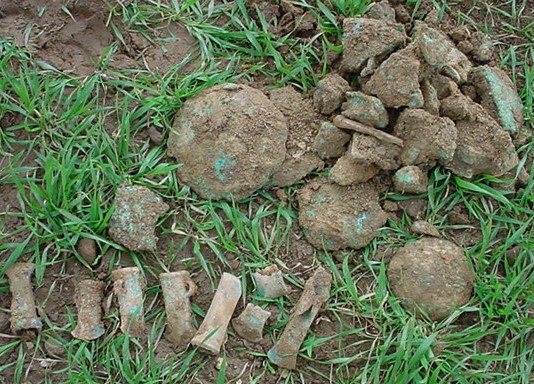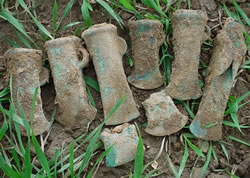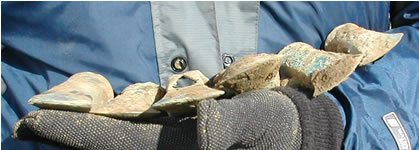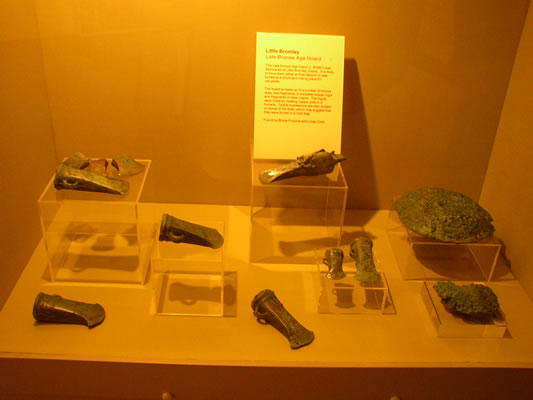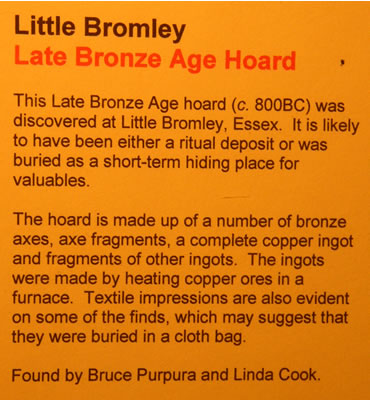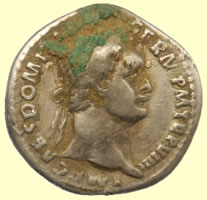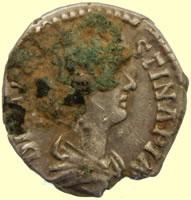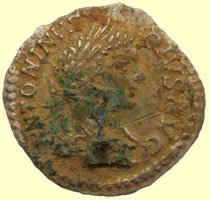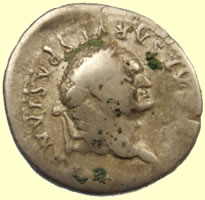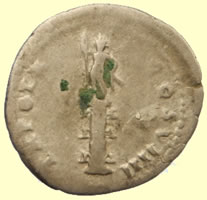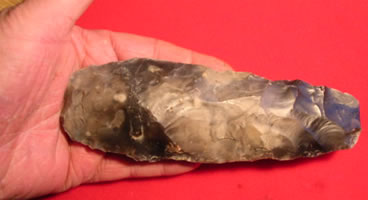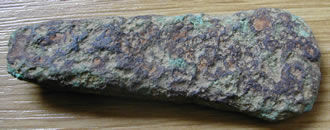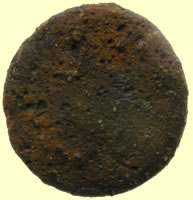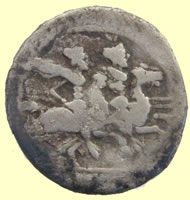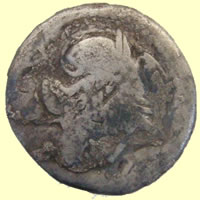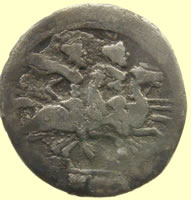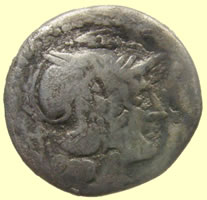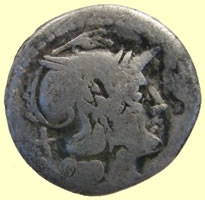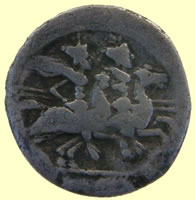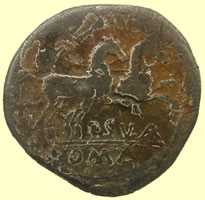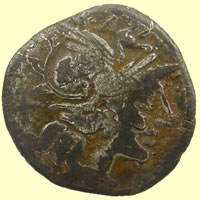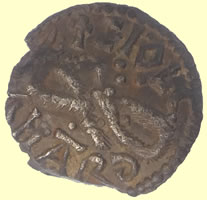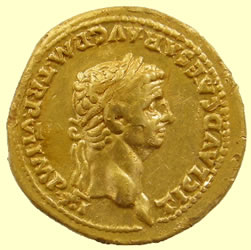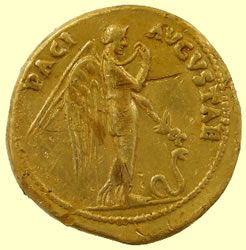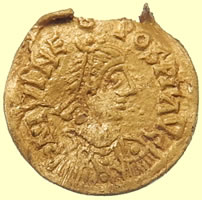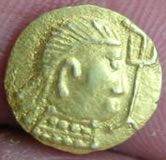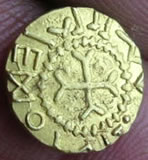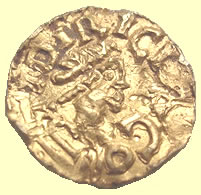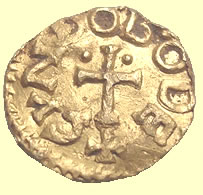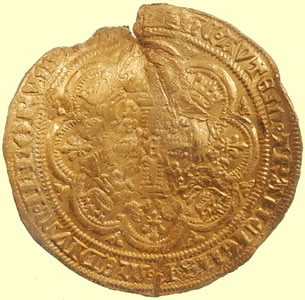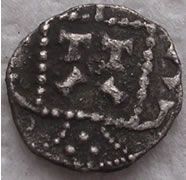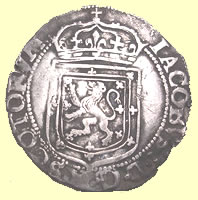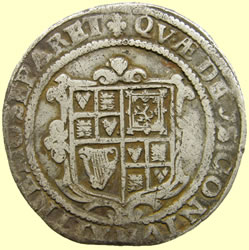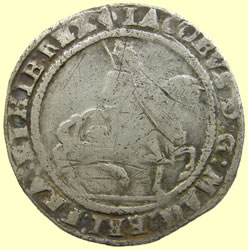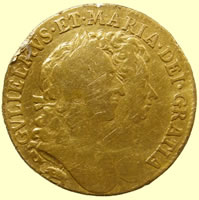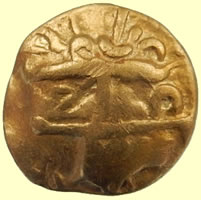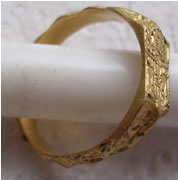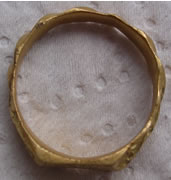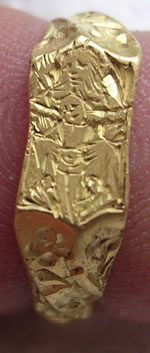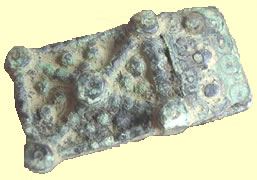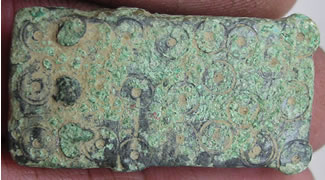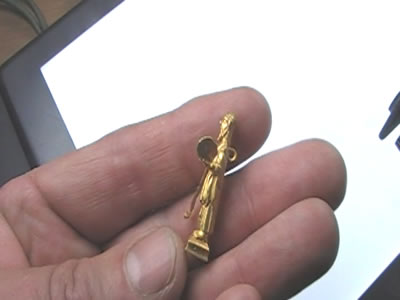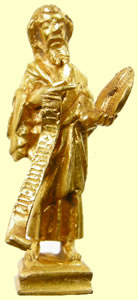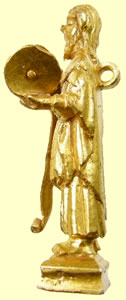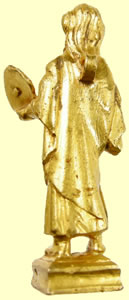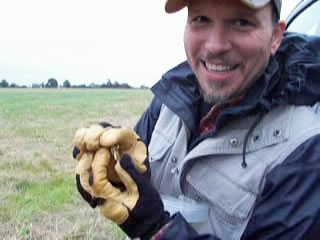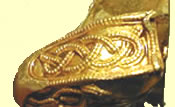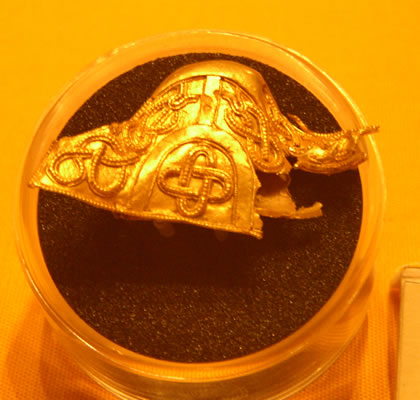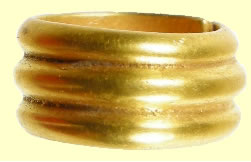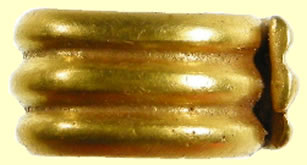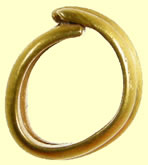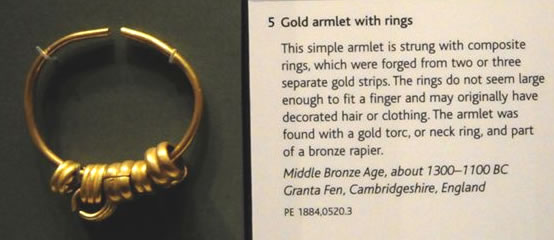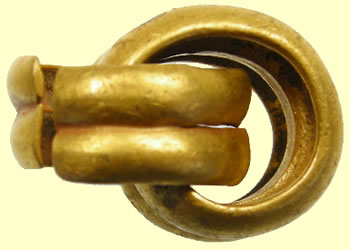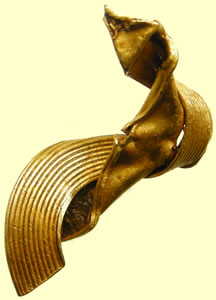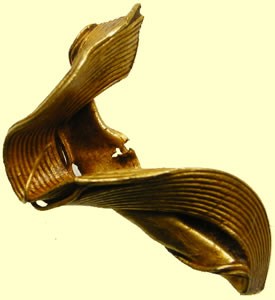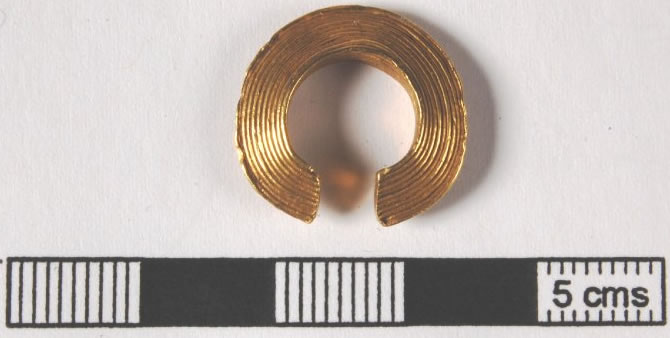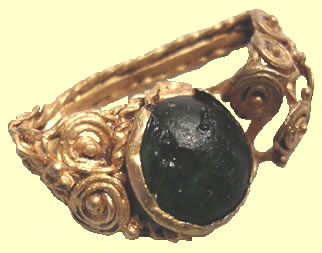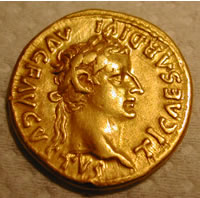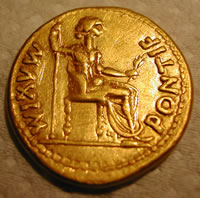

Metal detecting holidays in England with the World's most successful metal detecting club.20 years plus.
Twinned with Midwest Historical Research Society USA.
Colchestertreasurehunting club - Record book Oldest, biggest, rarest
|
Biggest find |
Mass Bruce's axe hoard - - 800 BC socketed axes and ingots - on display now in Colchester museum
|
Rarest and potentially the most valuable find ever made |
Added in 2019 and still going through the treasure process so valuation has not been set yet.
1300 BC gold neck torc - reported as treasure to museum - found by Cal Dave 33.72g
|
Largest coin hoard |
53 Roman silver coins - multiple finders- hoard first discovered by Mo Dan
|
Earliest finds - Flint and Bronze |
Penn Christy - Earliest find - Axe head - Circa 11000 BC Middle Stone Age (Mesolithic) flint axe head
Van Brent - earliest metal relic and rarest Bronze axe head find, 2000 BC flat axe, he now shares this record with Can Victor who found a 2000 BC votive axe offering below Sept 2008.
2000 BC - Canadian Victor
Earliest socketed axe - found by Fl Don Bronze Age (c.1500-1400BC) cast copper alloy primary shield pattern palstave, dating to the Acton Park Phase
|
Oldest silver coins |
Kansas Barry has the record for the oldest Roman silver coin found here at 211BC - this is the oldest Roman coin ever found in Britain as well.
As dug, nearly 'cooked' and final pictures - just sent to Mark for his final ID 17.81mm, 3.28g Equals the oldest coin found in Britain at 211 BC Early Roman silver coin - straight into 'cooker' to clean off horn silver crust This dates, as far as I can tell - since no trace of symbol has become visible beneath the horses or between the heads of the Dioscuri - to the earliest issue of actual Denarii, as distinct from the earlier Drachma-denominated silver coinage. It dates to the period 211-206 BC (according to the most recent scholarship on dating) and would be RSC # 2 (Roman Silver Coinage) - if that catalog number gives you some idea of how close to the beginning of the book it's found. This first coinage was anonymous, lacking even symbols to potentially indicate via association (or pun) the names of the families of moneyers. This is actually the 3rd type produced (so far as I can tell) "ROMA" in the exergue of this specimen appears to be in relief. On the very earliest ROMA was incuse, and a transitional type had ROMA partially incuse and partially in relief. The general types, however, the helmeted head of Roma, inspired by (and, frankly, copied from) the helmeted head of Athena on Corinthian didrachms) with "X" mark of denomination (10 Asses of bronze to the silver Denarius - later it would be re-tariffed at 16) and the Dioscuri, Castor & Pollux, galloping right with levelled lances would be among the very most common devices used on denarii over the next 150 years. When there was no specific bit of history or family fame being related on a moneyer's denarii, this was one of the 3 main "stock" types, along with Jupiter driving a quadriga and Victory driving a biga. I believe this is the earliest Roman coin you folks have turned up, to date. It is, at least, the earliest I recall being forwarded to me for identification. With the exception of the slightly earlier (and very much more rare) "Romano-Campanian" Quadrigati (Didrachmae), Drachmae and Semes, this is about as early as you can go in the "Roman" coin series. Mark
151BC Roman republican silver coin sent for ID - 2nd oldest coin ever found by the our club - Florida Chuck This is a denarius of P. Cornelius Sulla (same family as the famous dictator of the next century, but a different Publius Cornelius Sulla) dating to 151 BC - Mark
|
Rarest coins |
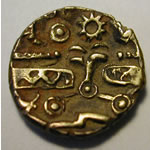 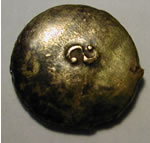 |
Alaskan Geo - rarest coin Celtic gold 1/4 stater , only one of it's type known
One of a kind Offa Rex penny 757-796 AD Offa Saxon silver penny 1.12g, 15.5mm Many thanks. I have recorded this as EMC 2019.0309. An important find. Best regards, Martin
|
Most valuable coin |
1st C Roman gold coin - sent for ID 19.6mm, 7.81g - Ill Mark Oh man, is that ever beautiful!
That is, of course, an Aureus of the emperor Claudius (41-54 AD) the presumed-to-be "simple-minded", somewhat disabled uncle of Caligula. He was seized upon by the Praetrorian guard as a tractible replacement after they had murdered Caligula, his wife and child. It turned out that Claudius was smarter than most of the Julio-Claudians and had merely allowed everyone to think he was simple-minded. This allowed him to hide in the background, out of the way of the endless palace intrigues. The successful ruse evidently kept him from suffering the sort of "mysterious" death which seemed to stalk all the other Julio-Claudians who might be in-line for or have some claim to being emperor. Once in power, he showed that far from being "simple", he was a shrewd and canny politician and proved to be a benificent ruler as well, righting a lot of the wrongs perpetrated by his evil nephew. Eventually, however, his love of women was his downfall. Marrying his neice, Agrippina Jr., the last of his succession of unfortunate marriages, he had inadvertantly adopted and brought into his home one of the true vipers in the Imperial nest, her son, the future emperor Nero. It is assumed that Agrippina, on her son's behalf, (or possibly even Nero himself) was responsible for feeding him a dish of deadly poisonous mushrooms. This removed the last impediment and cleared the way for Nero to become emperor.
This is one of the more common reverse types for Claudius' aureii, the PACI AVGVSTAE or "The Emperor's Peace". It has an interesting reverse type, too. Rather than Victory, whom you might assume was the winged character on the reverse, this is "Pax-Nemesis" performing a gesture associated with a uniquely Roman bit of superstition. She is drawing out a fold of her gown in what is called in some delicate circles an "Apotropaic gesture" - in other words, she's spitting on her own breast, which, like throwing a pinch of spilled salt over one's shoulder or touching wood, was a common superstitous custom among Romans and meant to deflect bad fortune.
This piece was struck in 41-42 AD at the imperial mint for precious metal coins, which happened at the time to be in the provincial capital at Lugdunum (modern Lyons) and coincidentally was also where the future emperor Claudius had been born.
This is actually one of the more common types of early Roman Imperial Aureii, but "common" here is all relative - particuarly in recent months, Roman Aureii have been bringing astonishing amounts of money - I wouldn't even venture a guess as to what the current market value of this piece might be - most likely at least in the 5-figures range of GBP's, Euros or Dollars.
Mark
Roman gold half solidus sent to Fitzwilliam museum for recording and ID 1.32g,14.1mm This is very interesting find, but unfortunately it is not Anglo-Saxon and neither is it a solidus. This is a semissis (half solidus) of Julius Nepos (474-5), from the Rome mint (RIC X, 3207). The damage mayhave been caused by removal of a mount.
|
Louisiana Sal - 1st English Saxon gold ever found in the club English Saxon Thrymsa gold coin - 'Witmen type' c620 -650 AD named after the hoard found in 1828. Sent off to the Fitzwilliam museum Corpus database for recording 1.26g, 11.46mm Recored as EMC 2007.0302.
|
Earliest hammered gold coin (non Romano/British) |
Boston Bud - Earliest hammered gold coin (non Romano/British) Early Continental (Merovingian Francia) (584-750), Ruler: anon. (tremissis) (590-675) |
| Largest gold coin |
Monster gold coin find - Min Mindy 1351-1352 Edward III gold noble -series C- E in centre of reverse cross - Closed E & C's - Lombardic M - reverse Roman N -annulet stops to reverse Obv EDWARD DEI GRA REX ANGL Z FRANC D hYB Ref Spink 1483 -JJ North 1144 33.46mm, 7.67g |
Earliest hammered silver penny coin |
NY Ken - earliest hammered silver penny coin - King Offa - 780 - 792 King of Mercia hammered silver 1.27g, 16.67mm
Mutilple finders - Earliest hammered silver coin (non Romano/British)Saxon C600-775 AD Silver Sceat 1.23g,11.15mm
|
Largest milled silver |
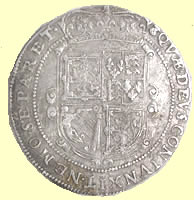  |
Can Bill - largest milled silver Charles 1st Scottish 30 shillings 14.95g, 35.63mm (360 pence) |
Largest diameter foreign hammered silver coin |
|
Veggie Mike - largest dia foreign hammered silver coin
James 1st Scottish Merk sometimes known as the half thistle dollar and value of 13 shillings and 4 pence ( 160 pence) 6.56g, 31.40mm |
Largest diameter English hammered silver coin found |
Monster find, rare - 1603 James 1st hammered silver half crown - 1st issue Lis mintmark 34.88mm - 14.79g |
Rarest and earliest milled gold coin |
Our rarest ever and earliest milled gold coin find - 1689 William and Mary milled gold full guinea - Lion in shield type, elephant under bust 11g, 25.2mm - Chicago Ron |
Earliest hammered gold coin found |
175 BC Celtic gold qtr stater Thanks to John Sills at the CCI for the ID - Found by VT Henry 12mm,1.96g ABC 34 Defaced Die quarter with a left-facing obverse bust obscured by lines and a left-facing horse and rider on the reverse with triskeles below. This type was struck somewhere in the French/Belgian border region in the 2nd century BC by an unknown tribe and possibly dates to around 175 BC plus or minus a couple of decades either way. Used to be very rare, I listed 17 examples in my 2003 book but there are perhaps 30 or so known now
|
Most stunning relic |
NH Dave - most stunning relic - Medieval Iconic gold ring - 2.96g, 18.87mm dia, 3,34mm w x 1.46mm thick On display in Colchester museum
|
Rarest find ever made |
|
NS Andy - rarest find ever made C10thC Anglo Saxon strap end 18.48g, 34.41mmL x 18.33mmW x6.53mm H Only one of it's type found in Britain - donated to Colchester museum by NovaScotia Andy 'It is probably an insular copy of a Carolingian style, or it could even be the product of a workshop located on the fringes of the Carolingian continent, maybe somewhere like Domburg on the coast of Frisia. 10th - 11th century in date'. |
Most valuable relic |
Found Sept 2009 - Solid gold medieval statue found by Tenn Brad
Script reads FRCO ++SMYUNC +DEI 32.80mm H ,11.46g
Brad's Video just after he dug it
The medieval gold statue was purchased by the Colchester museum and is now on display. This Saxon pommel was our current leader but is now in 2nd place - it was purchased by the Colchester museum and is now on display.
|
Ohio Bud - 2nd Most valuable relic Saxon (c.550-650AD) dagger pommel end piece
|
Oldest gold jewelry finds |
Monster find -Circa 1300 BC Bronze age gold open backed triple banded gold ring Org Ed 3.48g, 13.73mm dia x 6.74mm H Reported to Colchester museum as treasure - declared treasure at inquest and donated to museum by finder and landowner
On display at British museum
Stunning pair of solid gold 1000 BC armlet rings - found by Marl Ron 7.06g, 9.25mm W x 11..45mm dia
Bronze Age Tress Ring C1000BC Lock-RingsOrnaments, whose function is unknown, made from gold plates in triangular cross-section and secured by a binding strip, resulting in a hollow ring. The face plates can be decorated with repoussé decoration or with fine concentric incised lines imitating fine wire works. More rarely, lock-rings are made from face plates obtained from individual gold wires soldered together. References
3.12g,27.07mm long - Found by Ill Tim
|
2nd Mass Bill - oldest Roman/British gold ring find 4thC Roman gold ring with green stone On display in Colchester museum
|
Oldest Roman gold coin found - purest gold find |
Mich Tracy - Oldest Roman gold coin found - purest gold find
Tiberious 14 to 37 AD gold Aureus - tested as 97% ancient gold |
Other records - highest gold coin finder and most hoards found |
Most successful clubs gold coin finder - Chicago Ron - He has found 22 gold coins and holds the record for the oldest milled gold coin find. Most successful coin hoard finder - Chicago Ron , 9 hoards found so far
|
|
|
